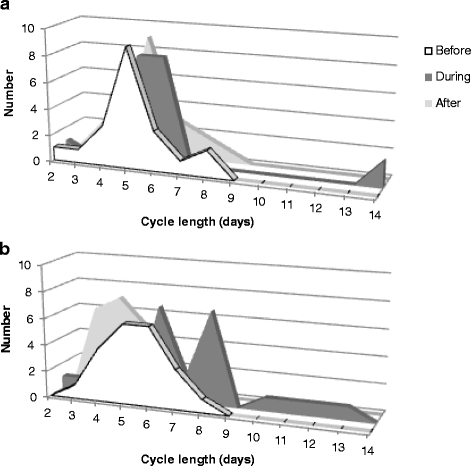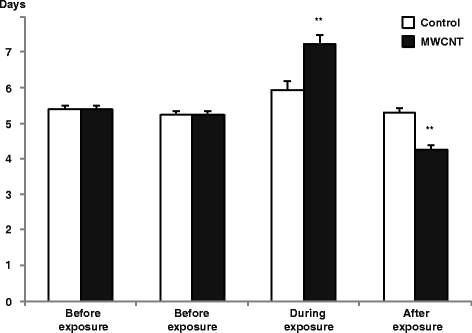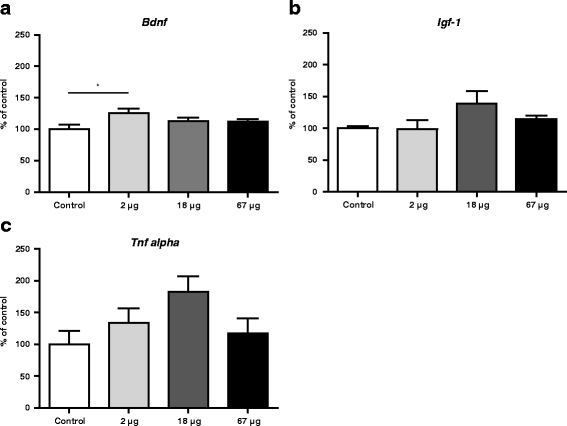Airway exposure to multi-walled carbon nanotubes disrupts the female reproductive cycle without affecting pregnancy outcomes in mice
- PMID: 28558787
- PMCID: PMC5450058
- DOI: 10.1186/s12989-017-0197-1
Airway exposure to multi-walled carbon nanotubes disrupts the female reproductive cycle without affecting pregnancy outcomes in mice
Abstract
Background: The use of multiwalled carbon nanotubes (MWCNT) is increasing due to a growing use in a variety of products across several industries. Thus, occupational exposure is also of increasing concern, particularly since airway exposure to MWCNTs can induce sustained pulmonary acute phase response and inflammation in experimental animals, which may affect female reproduction. This proof-of-principle study therefore aimed to investigate if lung exposure by intratracheal instillation of the MWCNT NM-400 would affect the estrous cycle and reproductive function in female mice.
Results: Estrous cycle regularity was investigated by comparing vaginal smears before and after exposure to 67 μg of NM-400, whereas reproductive function was analyzed by measuring time to delivery of litters after instillation of 2, 18 or 67 μg of NM-400. Compared to normal estrous cycling determined prior to exposure, exposure to MWCNT significantly prolonged the estrous cycle during which exposure took place, but significantly shortened the estrous cycle immediately after the exposed cycle. No consistent effects were seen on time to delivery of litter or other gestational or litter parameters, such as litter size, sex ratio, implantations and implantation loss.
Conclusion: Lung exposure to MWCNT interfered with estrous cycling. Effects caused by MWCNTs depended on the time of exposure: the estrous stage was particularly sensitive to exposure, as animals exposed during this stage showed a higher incidence of irregular cycling after exposure. Our data indicates that MWCNT exposure may interfere with events leading to ovulation.
Keywords: Developmental toxicity; Estrous cycle; Female; Fertility; Multi-walled carbon nanotubes; Nanomaterials; Ovulation; Pregnancy; Reproductive toxicity.
Figures





Similar articles
-
Effects of lung exposure to carbon nanotubes on female fertility and pregnancy. A study in mice.Reprod Toxicol. 2013 Nov;41:86-97. doi: 10.1016/j.reprotox.2013.05.006. Epub 2013 May 25. Reprod Toxicol. 2013. PMID: 23714338
-
Mouse pulmonary dose- and time course-responses induced by exposure to nitrogen-doped multi-walled carbon nanotubes.Inhal Toxicol. 2020 Jan;32(1):24-38. doi: 10.1080/08958378.2020.1723746. Epub 2020 Feb 7. Inhal Toxicol. 2020. PMID: 32028803 Free PMC article.
-
Pulmonary and pleural inflammation after intratracheal instillation of short single-walled and multi-walled carbon nanotubes.Toxicol Lett. 2016 Aug 22;257:23-37. doi: 10.1016/j.toxlet.2016.05.025. Epub 2016 May 31. Toxicol Lett. 2016. PMID: 27259835
-
Review of toxicity studies of carbon nanotubes.J Occup Health. 2017 Sep 28;59(5):394-407. doi: 10.1539/joh.17-0089-RA. Epub 2017 Aug 8. J Occup Health. 2017. PMID: 28794394 Free PMC article. Review.
-
Reproductive and developmental toxicity of carbon-based nanomaterials: A literature review.Nanotoxicology. 2016;10(4):391-412. doi: 10.3109/17435390.2015.1073811. Epub 2015 Sep 16. Nanotoxicology. 2016. PMID: 26375634 Review.
Cited by
-
Group II innate lymphoid cells and microvascular dysfunction from pulmonary titanium dioxide nanoparticle exposure.Part Fibre Toxicol. 2018 Nov 9;15(1):43. doi: 10.1186/s12989-018-0280-2. Part Fibre Toxicol. 2018. PMID: 30413212 Free PMC article.
-
Application of some nanoparticles in the field of veterinary medicine.Int J Vet Sci Med. 2019 Dec 26;7(1):78-93. doi: 10.1080/23144599.2019.1691379. eCollection 2019. Int J Vet Sci Med. 2019. PMID: 32010725 Free PMC article. Review.
-
Pulmonary exposure to carbonaceous nanomaterials and sperm quality.Part Fibre Toxicol. 2018 Jan 31;15(1):10. doi: 10.1186/s12989-018-0242-8. Part Fibre Toxicol. 2018. PMID: 29386028 Free PMC article.
-
Fetotoxicity of Nanoparticles: Causes and Mechanisms.Nanomaterials (Basel). 2021 Mar 19;11(3):791. doi: 10.3390/nano11030791. Nanomaterials (Basel). 2021. PMID: 33808794 Free PMC article. Review.
-
Maternal titanium dioxide nanomaterial inhalation exposure compromises placental hemodynamics.Toxicol Appl Pharmacol. 2019 Mar 15;367:51-61. doi: 10.1016/j.taap.2019.01.024. Epub 2019 Feb 1. Toxicol Appl Pharmacol. 2019. PMID: 30711534 Free PMC article.
References
-
- Johnston HJ, Hutchison GR, Christensen FM, Peters S, Hankin S, Aschberger K, et al. A critical review of the biological mechanisms underlying the in vivo and in vitro toxicity of carbon nanotubes: The contribution of physico-chemical characteristics. Nanotoxicology. 2010;4:207–46. doi: 10.3109/17435390903569639. - DOI - PubMed
-
- Saber AT, Jacobsen NR, Jackson P, Poulsen SS, Kyjovska ZO, Halappanavar S, et al. Particle-induced pulmonary acute phase response may be the causal link between particle inhalation and cardiovascular disease. Wiley Interdiscip Rev Nanomed Nanobiotechnol. 2014;6:517–31. doi: 10.1002/wnan.1279. - DOI - PMC - PubMed
Publication types
MeSH terms
Substances
LinkOut - more resources
Full Text Sources
Other Literature Sources

